You need only meet Nicolás and Elena Catena once to sense they are as genuine as the towering Andes Mountains that frame their Mendoza vineyards. Speaking to a sold out crowd at the 2014 Wine Summit Lake Louise at the Post Hotel & Spa, the best annual wine weekend on the continent, the unassuming first couple of Argentine wine spoke eloquently to the history of Catena Zapata, the storied malbec grape, and their highly successful family wine business that dates back to the arrival of Nicola Catena, who sailed from Italy to Argentina in 1898.
Nicola, the grandfather of Nicolás, escaped the great famine of Europe and is said to have celebrated his good fortune daily by eating a piece of raw steak for breakfast. Not long after arrival, he planted his first malbec vines in the Mendoza countryside, the year was 1902. It would be another 63 years before Nicolás Catena, son of Domingo, would enter the family business fresh from a PhD in economics, hoping to turn around a business struggling in an economy heading for a down turn faster than the rise in inflation.
In those days, the style of Argentine wine was based on the old Italian and Spanish model that, in a word, was oxidised. According to Catena, “They were Sherry-like reds and whites and at the time people preferred those characteristics.” His father Domingo expanded the winery and over time it became one of the largest vineyard holders in Mendoza, but Nicolas was determined to change the quality of Catena wines by working first in the vineyards and then at the winery.
A stint as a visiting professor at the University of California in the early 1980s introduced Catena to California wine. He was inspired by Napa Valley and noted its stunning win at the seminal 1976 Paris tasting, whose results resounded around the world, opening doors for New World producers to reach for the stars. It was Argentina’s chance to step up and out of 500-plus years of making mediocre wine.
Nicolás Catena returned to Mendoza with a new energy but if he was truly inspired by the New World he still believed strongly in the French wine model and set out to imitate the best of Europe. “The Californians talked about winemaking technology and tools but in the ‘80s no one mentioned terroir,” he said. Catena knew in the end it would come down to the dirt. His ace in the hole was Argentina’s alluvial soil, formed by melting glaciers. “They are poor in fertility and have no vigour. At the same time, we have another source of concentration, the sunlight. In order to explain the uniqueness of our terroir maybe this is the best explanation. Altitude and sunlight.”
Throughout the 1980s, Catena searched for the best places to plant vineyards in Mendoza. But it wasn’t until he had dinner in the early 1990s with the pre-eminent Bordelais vintner Jacques Lurton and served him his favourite cabernet sauvignon that he really saw the light. Lurton’s impression was the Catena cabernet was good but it tasted as if it was from the Languedoc. In other words, from a hot climate. From that moment on Catena’s obsession was to seek out cooler sites at higher altitudes.
There were vineyards at 800 metres above sea level but Catena decided to go to 1,500 metres. Even though he only paid $250 (U.S) a hectare, everyone, including his technical advisors thought he was loco. As it turned out, there was no frost, and if you were careful in the vineyard and didn’t increase yields you could ripen all the fruit. It was a good decision. Today the same land sells for $50,000 to $70,000 per hectare.
Once it was clear the malbec would survive, along with cabernet and chardonnay, at high altitudes the question was what they would do with the knowledge. It took another five years of work on the 60 year old Angélica vineyard before Catena okayed the first Catena Malbec in 1994, and not long after he set out to develop his own selection of clones, planting 145 separate clones in the La Pirámide vineyard before deciding on the best five. Today the best five have been planted on different terroirs and at different altitudes as the Catena family continues its quest to be a world leader in wine.
By 2001 Catena’s daughter Laura took over research and development at Bodega Catena Zapata. An emergency room physician with degrees from Harvard University and Stanford University, Laura’s energy led to even more success with the high altitude malbec. She had the viticultural team work plant by plant to isolate their finest high altitude fruit. The resulting Zapata plants were managed and harvested separately to isolate their incredible potential.
Interestingly, Catena is not worried about malbec being a one-trick pony. He has done much to uncover the story of the grape, including importing the original French variety from Cahors. The production and size was almost double what they were getting from the Argentine plants. “Why are they different? We do not have a good story for that but we know the plants from France give us much less concentration, making them uninteresting”.
What he does confess to is that he likes to blend a little cabernet sauvignon with his malbec, something his father used to do. Catena loves the fact that the cabernet sauvignon brings a touch of bitterness and complexity to the blend, in essence reducing the highly attractive, but inherently sweet fruit that at one level makes malbec so desirable to consumers but on another level leaves it a one-dimensional red.
Nicolás and Elena are more than happy to have Laura in charge of the next generation of wines at Catena. They will almost certainly reach heights above and beyond their spectacular altitude.












